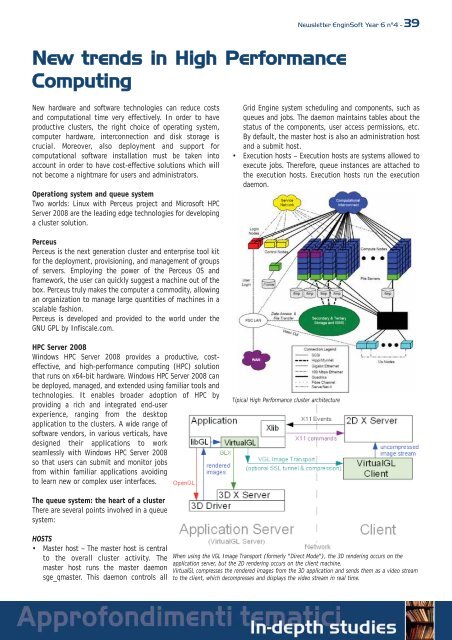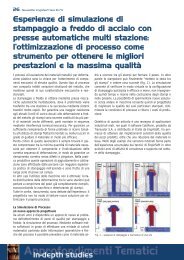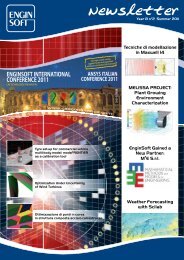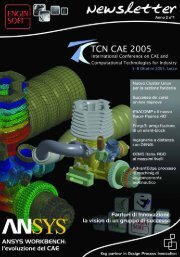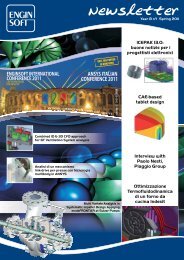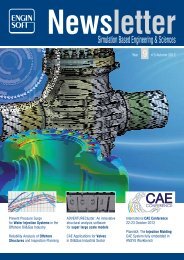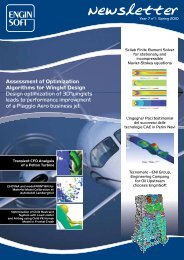software training courses 2010 corsi di addestramento ... - EnginSoft
software training courses 2010 corsi di addestramento ... - EnginSoft
software training courses 2010 corsi di addestramento ... - EnginSoft
Create successful ePaper yourself
Turn your PDF publications into a flip-book with our unique Google optimized e-Paper software.
New trends in High Performance<br />
Computing<br />
New hardware and <strong>software</strong> technologies can reduce costs<br />
and computational time very effectively. In order to have<br />
productive clusters, the right choice of operating system,<br />
computer hardware, interconnection and <strong>di</strong>sk storage is<br />
crucial. Moreover, also deployment and support for<br />
computational <strong>software</strong> installation must be taken into<br />
account in order to have cost-effective solutions which will<br />
not become a nightmare for users and administrators.<br />
Operationg system and queue system<br />
Two worlds: Linux with Perceus project and Microsoft HPC<br />
Server 2008 are the lea<strong>di</strong>ng edge technologies for developing<br />
a cluster solution.<br />
Perceus<br />
Perceus is the next generation cluster and enterprise tool kit<br />
for the deployment, provisioning, and management of groups<br />
of servers. Employing the power of the Perceus OS and<br />
framework, the user can quickly suggest a machine out of the<br />
box. Perceus truly makes the computer a commo<strong>di</strong>ty, allowing<br />
an organization to manage large quantities of machines in a<br />
scalable fashion.<br />
Perceus is developed and provided to the world under the<br />
GNU GPL by Infiscale.com.<br />
HPC Server 2008<br />
Windows HPC Server 2008 provides a productive, costeffective,<br />
and high-performance computing (HPC) solution<br />
that runs on x64-bit hardware. Windows HPC Server 2008 can<br />
be deployed, managed, and extended using familiar tools and<br />
technologies. It enables broader adoption of HPC by<br />
provi<strong>di</strong>ng a rich and integrated end-user<br />
experience, ranging from the desktop<br />
application to the clusters. A wide range of<br />
<strong>software</strong> vendors, in various verticals, have<br />
designed their applications to work<br />
seamlessly with Windows HPC Server 2008<br />
so that users can submit and monitor jobs<br />
from within familiar applications avoi<strong>di</strong>ng<br />
to learn new or complex user interfaces.<br />
The queue system: the heart of a cluster<br />
There are several points involved in a queue<br />
system:<br />
HOSTS<br />
Master host – The master host is central<br />
to the overall cluster activity. The<br />
master host runs the master daemon<br />
sge_qmaster. This daemon controls all<br />
Newsletter <strong>EnginSoft</strong> Year 6 n°4 - 39<br />
Grid Engine system scheduling and components, such as<br />
queues and jobs. The daemon maintains tables about the<br />
status of the components, user access permissions, etc.<br />
By default, the master host is also an administration host<br />
and a submit host.<br />
Execution hosts – Execution hosts are systems allowed to<br />
execute jobs. Therefore, queue instances are attached to<br />
the execution hosts. Execution hosts run the execution<br />
daemon.<br />
Tipical High Performance cluster architecture<br />
When using the VGL Image Transport (formerly "Direct Mode"), the 3D rendering occurs on the<br />
application server, but the 2D rendering occurs on the client machine.<br />
VirtualGL compresses the rendered images from the 3D application and sends them as a video stream<br />
to the client, which decompresses and <strong>di</strong>splays the video stream in real time.


